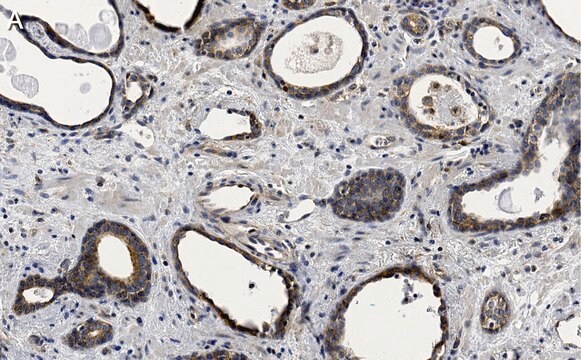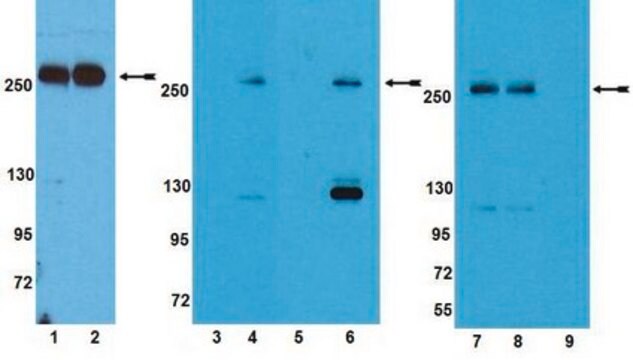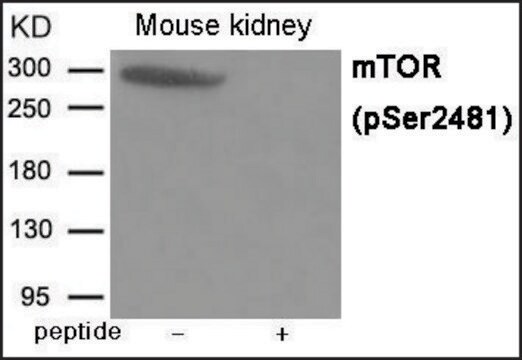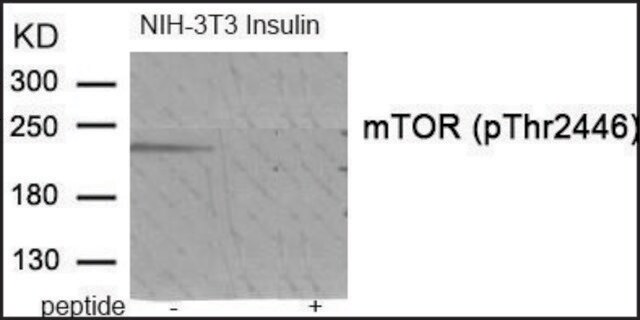09-213
Anti-phospho-mTOR (Ser2448) Antibody
Upstate®, from rabbit
Synonym(e):
FRAP1, FRAP, FRAP2, RAFT1, RAPT1, FK506 binding protein 12-rapamycin associated protein 1
About This Item
Empfohlene Produkte
Biologische Quelle
rabbit
Qualitätsniveau
Antikörperform
affinity purified immunoglobulin
Antikörper-Produkttyp
primary antibodies
Klon
polyclonal
Aufgereinigt durch
affinity chromatography
Speziesreaktivität
human
Verpackung
antibody small pack of 25 μg
Hersteller/Markenname
Upstate®
Methode(n)
western blot: suitable
NCBI-Hinterlegungsnummer
UniProt-Hinterlegungsnummer
Versandbedingung
ambient
Posttranslationale Modifikation Target
phosphorylation (pSer2448)
Angaben zum Gen
human ... MTOR(2475)
Allgemeine Beschreibung
Spezifität
Immunogen
Anwendung
PI3K-, Akt-, & mTOR-Signalübertragung
Glukose-/Glykogenstoffwechsel
Insulin-/stoffwechselassoziierte Signalübertragung
Adhäsions-Proteine (CAMs – Zelladhäsionsmoleküle)
Qualität
Western Blot Analysis:
This antibody detected mTOR phosphorylated on Ser2448 in EGF-treated and untreated A431 cell lysates.
Zielbeschreibung
An uncharacterized band may be obsereved at ~59 kDa
Physikalische Form
Hinweis zur Analyse
EGF-treated and untreated A431 cell lysate.
Sonstige Hinweise
Rechtliche Hinweise
Sie haben nicht das passende Produkt gefunden?
Probieren Sie unser Produkt-Auswahlhilfe. aus.
Empfehlung
Analysenzertifikate (COA)
Suchen Sie nach Analysenzertifikate (COA), indem Sie die Lot-/Chargennummer des Produkts eingeben. Lot- und Chargennummern sind auf dem Produktetikett hinter den Wörtern ‘Lot’ oder ‘Batch’ (Lot oder Charge) zu finden.
Besitzen Sie dieses Produkt bereits?
In der Dokumentenbibliothek finden Sie die Dokumentation zu den Produkten, die Sie kürzlich erworben haben.
Unser Team von Wissenschaftlern verfügt über Erfahrung in allen Forschungsbereichen einschließlich Life Science, Materialwissenschaften, chemischer Synthese, Chromatographie, Analytik und vielen mehr..
Setzen Sie sich mit dem technischen Dienst in Verbindung.








